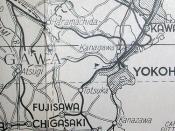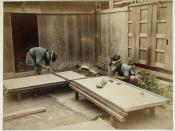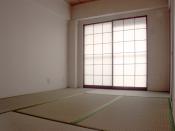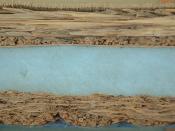"In an Ozu film, the low height of the director's frame may be meant to suggest the more relaxed, meditative perspective of a Japanese looking at the world from the floor of a tatami room"ÃÂ (Corrigan, 2001).
Ozu film expresses Japanese daily life and culture because those are his main theme to make his film. The titles of his film help audience to imagine Japanese daily life. An Autumn Afternoon is English title and it's translated indirectly. In original or Japanese title, it is Sanma no Aji, which means the Taste of Sanma. For me as a Japanese, the title reminds me of my mother's cooking taste. Usually, the smell of grilled Sanma is the typical image of mother's cooking or home for many of common Japanese people. Sanma is very common and familiar fish for many Japanese. Although the title infers Japanese life, it is the camera work that is more effective to show Japanese culture.
He set and stayed the camera in low position, which was one of his unique techniques because the camera position represents the perspective from tatami floor in his film. The use of the low angle technique has two meanings; one is to make the flat style of Japanese traditional architecture three dimensional; another is to show the "meditative perspective"ÃÂ of a Japanese looking at the world from the floor of a tatami room. Ozu uses the low angle for using the spaces so that he can show Japanese culture that is his theme to make film.
Ozu was influenced by the Japanese tradition in his use of space. Japanese traditional style of living is floor culture. We sleep, eat, and study, and do everything on the floor. The floor is always covered with tatami mats, which are used to measure the room size that Westerners usually measure by feet by feet. Tatami is very closely related to our everyday life. Because Ozu filmed everyday life of Japanese, he used the low angle that reminds us of the perspective of tatami floor.
Ozu was successful in visual design, such as "upright shapes and parallel lines arranged for balance across the frame, a tendency toward bilateral symmetry on the vertical axis, and static elements near the edges of the frame which introduce graphic equivalences or tensions"ÃÂ (Bordwell, 76). A single, highly controversial framing choice, however, the most distinctive shot of Ozu shots. The urge to make every image sharp, stable, and striking is the "ÃÂdominant' of each shot, and as always in art the dominant reforms all the techniques under its way. The most remarkable and puzzling deformation takes place in the choice of camera position"ÃÂ (Bordwell, 76). Ozu sets the camera two to three feet off from the ground, and the position is constant and unvaried. In my concern, because of Japanese architecture, he sets the camera position two feet above from the ground. Traditionally, the floor of Japanese house is "elevated at least a foot and a half, or two feet above the ground"ÃÂ (Morse, 15). The camera position of low level is the same as the eye level view of a person seated on the floor, which reminds the "ÃÂtraditional' point when the Japanese sits on a tatami mat. Also, Ozu's camera position reminds the home-drama genre. What makes Ozu's camera seem "ÃÂlow' is not its angle but its height. Therefore, he does not shoot from a low camera angle. Almost always the camera is level, or tipped only a few degrees up from a horizontal axis. Ozu's rule is to set the lens axis between halfway and two-thirds of the way down the object to be filmed. When shooting a human figure, this position puts the head quite high in the shot. In filming something close to the ground "ÃÂ a baby, a table, a slumped-over person "ÃÂ the camera position is elevated. Astuda recalls how Ozu and his crew would move up through a building floor by floor, trying out camera positions at different windows, in order to find the ideal horizontal level for shooting the building opposite. Thus Ozu's camera position is not absolute but proportional, always lower than what it films but varying in relation to the subject's height."ÃÂ "This fact makes it untenable to identify the camera position with an "ÃÂinvisible observer' seated in the tatami. To apply this idea to Ozu's framing propels us tepidly toward absurdity. First, the camera is almost never at the literal height of a seated observer, as Atsuda demonstrates in Wenders' film Tokyo-Ga. Ozu also used an even lower tripod, which forced the operator ro stretch out on the ground. Secondly, what sort of observing entity is almost always lower than anything it sees, even in streets, train aisles, an office corridors? Third, Ozu changes the camera;s height varies according to whether a figure is seated or standing or according to the distance of the compositional elements from one another.
In addition to showing Japanese tradition, the camera position of low level reflects the same eye level view of the seated movie audience. The tatami position of Ozu's camera placed us directly in the room with the characters, at the level of the tatami mats. This position of camera makes us feel that we are a part of the scene and also an objective observer at the table. Ozu has no interest in portraying characters because he thinks of his audience as more important than them. He uses "familiar size"ÃÂ systems that allow us to occupy the space in the same way the characters do. Placed on the tatami. Each person is seen in perspective according to distance, and Ozu's minimal camera movement confirms our viewer status. Thus the tatami position supports this equality with characters.
The vertical line and the materials on the foreground are the accent to make solid image. Ozu emphasized on the vertical lines because of two reasons. He does not focus on the floor and cannot include the ceiling. According to his assistant Mr. Atsuda, he does not take much area of floor because he hates the tatami mats on the screen. Moreover, he cannot comprise the ceiling because of the oblong screen. Therefore, the vertical objects, such as pillars, paper sliding doors, and windows, have the significant existence. Also the materials on the foreground put emphasis on the depths. Ozu filmed Japanese traditional flat architecture, while he makes it solid by emphasis on vertical lines. For Ozu, the low angle makes easier to show the Japanese traditional house in a good composition. Japanese traditional houses are usually flat and simple in structure. Ozu filmed Japanese traditional flat architecture, while he makes it solid by emphasis on vertical lines. According to Morse, the author of Japanese homes and their surroundings, Japanese traditional house is very simple and flat, and there are some reasons why it is said to be so. First, the frame work of an ordinary Japanese dwelling is simple, and primitive in structure because it consists of a number of upright woods and inclines to the roof above. One major difference between Japanese and western houses is the treatment of partitions and outside walls. In the Japanese house, there are two or more sides that have no permanent walls, while Western house has solid and permanent walls. In stead of walls, Japanese uses removable sliding doors to divide rooms, such as Fusuma (see photo). For communication between the rooms, swinging doors are not necessary. The whole side of a house may be flung open to sunlight and air. As a substitute for undoes, the outside screens, or shoji, are covered with white paper, allowing the light to be diffused through the house.
this absence of paint, with the gray and often rain-strained color of the boards, leads one to compare it with similar unpainted buildings or home. With one's eye accustomed to the bright contrasts of American houses with their white, or light, painted surfaces; rectangular windows, black from the shadows within with glints of light reflected from the glass; front door with its pretentious steps and portico; warm red chimneys surrounding all, and a general trimness of appearance outside, which is by no means always correlated with like conditions within, - one is too apt at the outset to form a low estimate of a Japanese house. An American finds it difficult indeed to consider such a structure as a dwelling, when so many features are absent that go to make up a dwelling at home, - no doors or windows such as he had been familiar with; no attic or cellar; no chimneys, and within no fire-place, and of course no ceremony mantle; no permanently enclosed rooms and as for furniture, no beds or tables, chairs or similar articles,. "ÃÂ at least, so it appears at first sight."ÃÂ Within, also, there are hut few partitions which have similar stability; in their steal are slight sliding screens which run in appropriate grooms in the floor and over head. These graouse work the limit of each room.
Finally, I will examine these two things, which are low angle techniques and Japanese culture, by using the film An Autumn Afternoon. Through the film, Ozu uses the low angle techniques most of the time. There are some sequences that I thought it represents the Japanese daily life. First is the scene Katayama's daughter, Michiko, is preparing for her father's dinner. This perspective is as if we are seeing this scene from the theater seat. In additon, this point of view is the perspective when Japanese sees the person from the tatami floor.





